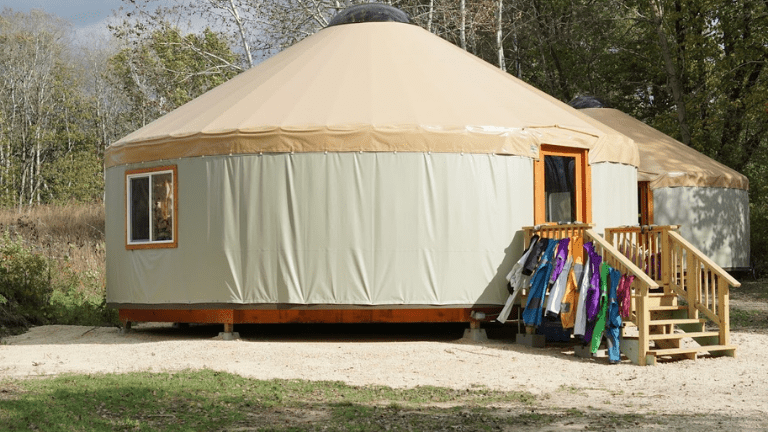On every day of the school year, teachers Cindy Raimer and Walter Sams make a trek through the woods to get their yurt classrooms ready for their students. They work at The Riveredge School, an elementary school in Wisconsin focused on outdoor learning. No, it’s not an affluent private school program. It’s a public charter school, available tuition-free for anyone in the area.
The yurt classrooms on the school’s grounds are in partnership with the nearby 379-acre nature center with the same Riveredge name who also use them on weekends and in summers. It took five days and lots of volunteers to get the yurts up and running—they have full electricity, a ceiling fan, a propane heater, windows, and two exit doors.
Cindy and Walter teach 2nd and 4th/5th grade in the yurts every single day, no matter the weather. Even on sub-zero days, which happens in Wisconsin, they just turn the heat up a notch or two and keep going. We sat down with Cindy and Walter to learn more about teaching in a yurt and their passion for outdoor education. Here’s what they had to say.
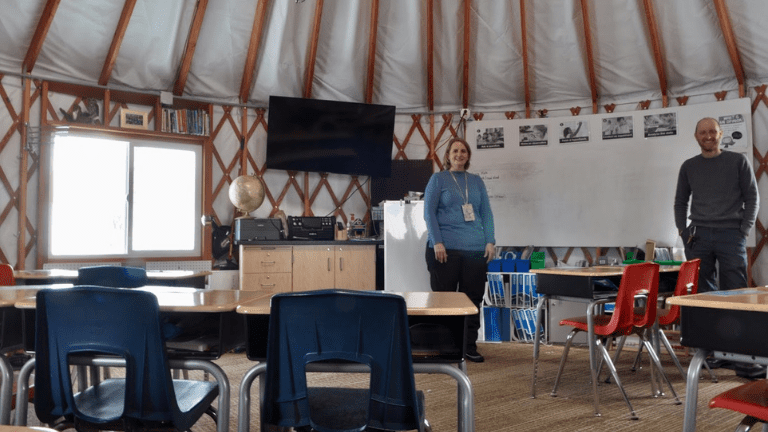
Why did the school choose yurt classrooms?
CINDY: The yurts were always part of the original vision of the school. Some of our organizers had visited another environmental school where yurts were successful, and they wanted to do the same here. As a plus, our yurts can be dismantled or moved if needed.
What’s it like to teach in a circle?
WALTER: You automatically feel like you’re in a special place. Circles are actually more natural than squares—there are more round edges than square edges in the natural world. Of course, it does take a little getting used to at first, but being in this special place opens you up to learning and seeing the world in a different way.
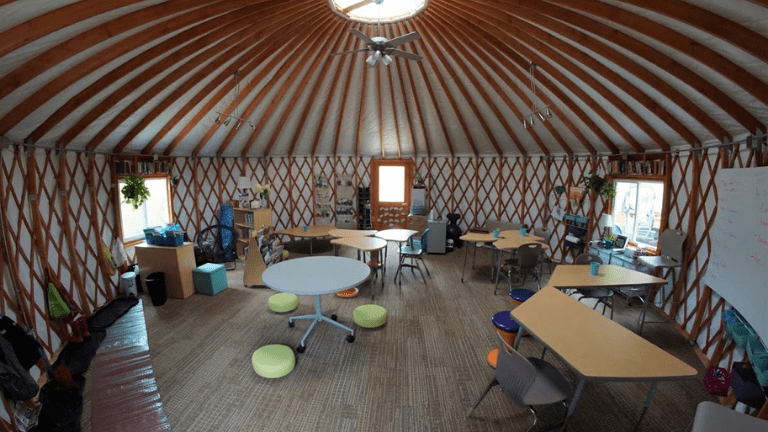
[contextly_auto_sidebar]
How is your school different from a more traditional school?
CINDY: As someone who came from a traditional school background, one of the biggest differences at this school is that we don’t have to be quiet or walk in our hallways. We can actually run, skip, or express ourselves in any way that we feel. In a traditional school, those transition times for students would often be stressful—you have to walk just so or be really quiet. But our transitions here are filled with observation and wonder. Then I see how this extends into the learning environment for students. It even reduces behavior issues overall. And it’s just by letting kids be kids.

How has COVID impacted your approach?

How does an outdoor education benefit kids?
WALTER: Our kids are more physically engaged compared to any elementary school that I’ve ever seen. On an average day, my group probably hikes five to seven miles. This gives you a different kind of energy for your body and is great for learning.
So you really teach in yurt classrooms every day—even in the freezing temperatures of winter?
CINDY: We do! In my yurt we keep the thermostat set at 60 degrees, and we’re fine. We don’t heat the yurts at night, but then they’re set on a timer to start again at 7 AM and they get warm extremely quickly. We’re just used to it.
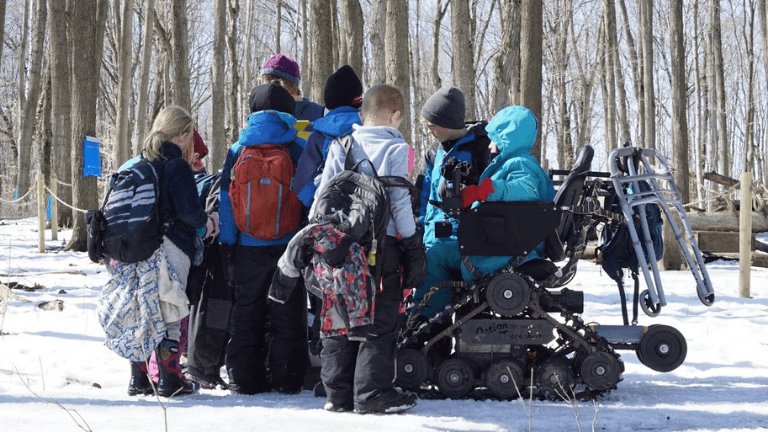
What does a typical day look like for your students?
CINDY: At our school, everyone spends a significant time outside. My class has a long morning hike, regardless of the weather. We will usually do writing and math indoors, and then pretty much everything else is outside. Even our closing circle every day is outside. We can do so much outside. For instance, we have hands-on science lessons outside. And my guided reading groups often take place in hammocks—teachers pull kids or groups out as needed to work at picnic tables. We really do integrate the outdoors in everything.

How do you get students used to yurt classrooms and the outdoors in general?
WALTER: Almost everything in a traditional classroom can also be done outside. The trick is acclimating your class to it. It probably takes us a month to a month and a half to just get our students used to being outside and learning in this environment. And you have to be flexible along the way. My mini-lesson for read-aloud for the day may go to the wayside because the students saw some squirrel innards at the side of the trail. It happens, and sometimes you just have to go off track and enjoy the moment that you’re having right there.

How has it been coming from a traditional school?
CINDY: To be honest, I was a little nervous when I started here this year. I’ve always loved science and nature, but I was nervous about how to transition to this environment. But now I wouldn’t trade it for a traditional school at all. I love the freedom it gives kids. I love not policing kids’ behaviors. We do so much here and kids learn so much. We go cross country skiing and snowshoeing in winter. We’ll be tapping maple trees in spring. And we have a tree-climbing class coming up, too.
What’s your tip for teachers who might want to bring more of the outdoors into their classrooms?
WALTER: Take a couple of kids outside your school and just ask them what natural things they see. It will bring to your attention what you might be missing as an adult. It gives the students the chance to be the explorer, and tuning into those and asking students about them is a really good first step. There are also plenty of resources in the environmental world to tap into as a teacher. Look for curriculum online—Project Wild has good material. Help your students find ways to bring nature inside. And look for an environmental education conference to attend in your state.
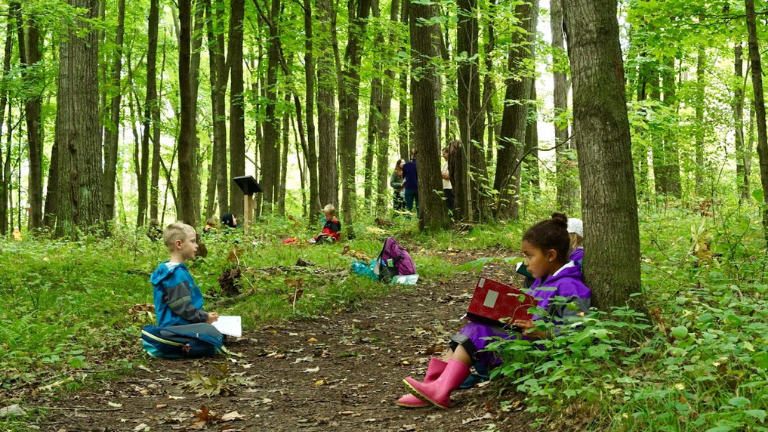
While the yurts at Riveredge are used as full-time classrooms, yurts have become a growing trend as a way for schools to create outdoor classrooms. They can be a bit pricey when you buy through a company, but many schools have found them to be a great option with the proper funding and support. Learn more about the yurts at Riveredge and the school itself on their website.
Want more articles like this? Be sure to subscribe to our newsletter.
Plus, tips, tricks, and ideas for winter outdoor learning.

